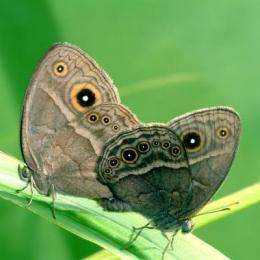Sexy or repulsive? Butterfly wings can be both to mates and predators

Butterflies seem able to both attract mates and ward off predators using different sides of their wings, according to new research by Yale University biologists.
Trying to find the balance between these two crucial behaviors is one of nature's oldest dilemmas, according to Jeffrey Oliver, a postdoctoral associate in Yale's Department of Ecology and Evolutionary Biology and lead author on the study, which appears online today in the journal Proceedings of the Royal Society B: Biological Sciences.
"You want to be noticeable and desirable for mates, but other onlookers, including predators, are paying attention to those signals as well."
Oliver was interested in whether the eyespots on the upperside of butterflies' wings - specifically, those of bush brown butterflies - serve a different purpose than the ones on the underside. Ever since Darwin's time, biologists (including Darwin himself) have postulated whether the upperside patterns could be used to attract mates, while at the same time, those on the underside could help avoid predators.
Working with Yale biologist Antónia Monteiro, Oliver used new tools to put the old theory to the test. Using different evolutionary models, he found that the eyespots on the upperside of the butterflies' wings appear to evolve much more quickly than those on the underside, meaning they appear and disappear frequently through the course of evolution. The result is consistent with the theory that these are used to attract mates, as signals used for sexual selection tend to evolve faster than others.
The study is the first to employ evolutionary history models to show that a species can use the same signal - in this case, eyespots - on different areas of its body to communicate different messages.
While butterflies often sit with their wings folded together and their undersides showing, they can flash a hidden eyespot on their forewings to confuse predators and give themselves time to escape. Exactly how the upperside eyespots communicate with potential mates is not fully understood, Oliver said, although it's thought they might help butterflies identify each other, which would help keep different species from cross-mating.
Next, Oliver will use longer evolutionary timescales to study where and how eyespots evolved, as well as whether they developed all at once, or independently over time.
Other authors of the paper include Kendra Robertson (State University of New York at Buffalo).
Source: Yale University (news : web)

















